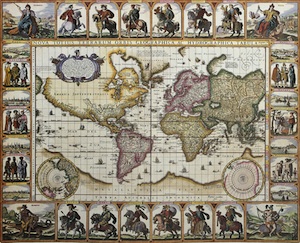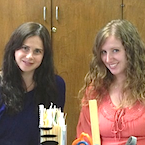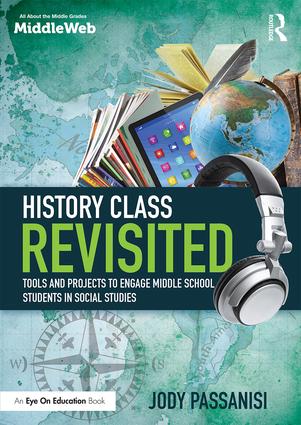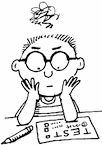Tips for New History Teachers
A MiddleWeb Blog
 by Aaron Brock, Shara Peters and Jody Passanisi
by Aaron Brock, Shara Peters and Jody Passanisi
Congratulations on your new social studies class! Whether you are teaching fourth grade social studies, or seventh grade history, you are probably feeling a combination of excitement and trepidation. Maybe we can help with the trepidation!
The three of us who contribute to the Future of History blog got together to brainstorm what we wished we’d known our first year of teaching. We’ve tried to narrow our focus to the particular needs of the new teacher in the social studies classroom.
Many of our “tips” are things you’ve probably heard or tried out in your teacher preparation programs, but we know that being reminded of what’s essential never hurts.
Here’s what we came up with – hope it’s helpful!
Curriculum:
• The volume of information in a history/social studies class is overwhelming. Talk to a veteran teacher and figure out what topics are MOST important.
• That being said, most schools hold students to particular standards, whether state or the new Common Core. Make sure that you know what your school/state expects students to know.
• 
• In a fact-based discipline, we need to focus on big ideas, patterns, and themes in history–don’t get bogged down in details that your students are likely to forget when they are done with your class.
• Even if you think you aren’t going to use it, read the textbook–so you understand what’s there.
• Any time you use texts and resources with alternate (political) perspectives, make sure you introduce them as such, and try to provide the other perspectives as well.
• In this day and age, history is most definitely not just memorization. Give your students the skills to analyze history, detect bias, and evaluate historical events.
• TeachingHistory.org, Finding Dulcinea and Facing History are among some great web-based resources that can help you help students to think critically about historical sources and what they find on the Internet.
Classroom Setup:
• Have a timeline in your classroom of the major events you cover in class–especially if you are teaching thematically.
• Maps are very important in helping students contextualize the area they learn about. Get lots of them! And remember to constantly refer to them while you teach.
• It’s nice to have visuals displayed around your classroom, but only put something up if it is really relevant to your curriculum.
• Arrange your classroom to allow for collaboration.
Teaching Toolbox:
• Even though we have content to convey, the strategies and teaching are as, if not more, important than the content. Remember that you are teaching students about history, as opposed to teaching history to students.

• Write a bunch of “Do Nows” ahead of time so you have them in your bank. Make sure they are relevant to the lesson you are about to teach — these class-starter activities will help your students realize that you are going to maximize your time with them, and the learning begins as soon as they enter the room.
• Find someone you respect and trust, whether at your site or another school, to talk about history content and the way you are teaching it.
• Keep a running list of things you want to change in your lessons for next school year. We promise, you won’t remember it if you don’t write it down!
• If you haven’t already, join an online professional learning network like Twitter. Some of the good hashtags for history teachers are #sschat and #historyteacher. Find interesting people to follow in the education field.
• Look into what your national association (NCSS) has to offer teachers at the middle level.
 Assessment:
Assessment:
• Never give an assessment of any kind that you can’t complete yourself.
• Make sure your assessments are REALLY assessing the information or skills that you want your students to take with them after they have completed your class.
• Don’t test students on information that does not have that much historical importance or relevance to your overall learning goals.
Most of all: When in doubt, trust yourself and go with your gut. Soon you’ll have a room full of young historians, and you’ll find yourself doing many of the things in this list without even thinking about them.
What have we forgotten? If you’re a veteran teacher, include your history/ social studies teacher tips in the comments. If you’re a new teacher with a lingering question, please ask it here!
______________



Follow Jody and Shara at their blog and on Twitter @21centuryteachr.




































I am a new-ish teacher, recently graduated from an MAT program in history. In the program, we learned great techniques for creating high-quality, engaging history units that focus on skills not content. During my practicum, I spent hours crafting my lessons for the next day (gathering primary sources, making the language accessible to all, crafting DTPs, etc…), and I was only prepping for one class. My position this year is at a small, international school. I teach 5 different classes on a 90 minute, alternating block schedule.
What tips do veteran teachers have for managing so many preps and maintaining my pedagogical approach? I don’t want to be a teacher who just turns kids to the textbooks, but I can see how that happens sometimes. Any advice would be much appreciated.
If your students are reading at grade level, the easiest way to avoid burning out while still remaining true to your pedagogical philosophy is to find a variety of texts that cover your subject matter. Have the students annotate sections of text about the same content, then use an I-chart (you can find these online) or similar tool to have them compare the similarities and differences in the authors’ perspectives. Howard Zinn’s “Young Person’s History of the United States” is a good contrast to any standard textbook. There is nothing wrong with using a textbook to teach students to look for author intent while still covering some of the content that we are expected to by virtue of our Social Studies credentials.
In my experience, if you try to be pedagogically perfect with an overwhelming workload, it can be counterproductive. To paraphrase SunTzu’s “Art of War,” ‘Attempting to cover all areas will make you weak in all areas.’ Anchor each class in a few really excellent thinking/writing/debating lessons, and allow lessons to get content-heavy when you need breathing room.
Hope this helps.
Thank you for the tips – I have been a teacher of 4th/5th grade for 12 years and have been asked to move to middle school next year. I will be teaching one class each of 6th, 7th, and 8th grade Social Studies and will do Library in the afternoon. I love history, have my degree, know the content, however I am also feeling a bit overwhelmed. Middle school is very different than 4th grade – can I still teach thematically? Where do I begin? Unfortunately, the Social Studies Department has been almost non-existent for several years with several teachers covering classes. This is a way for that to change to have some continuity.
Thank you for creating this great blog site. I am looking into blogging and what kind of material to have on the site. Who are the main people that visit your blog? parents, students,teachers? Any ideas are helpful
Thanks
J.Cisneros
The most important thing you can share with your middle school history students is your own enthusiasm for the content. To show them that learning about history can be fun and exciting, you have to communicate to them that you are excited, and having fun! I use slideshows, videos and songs as much as possible to scaffold and support the textual input to which students are exposed.
Two great sources of visual and audio materials are Mr. Gray’s stuff on teacherspayteachers.com and youtube’s history teachers music videos. I cannot strongly enough suggest Wiggins & Tighe’s “Understanding by Design.” I got it on Amazon for less than $5, shipping included, and it solidified things I was trying to do, but not as successfully as I would have wanted. It basically structures the way that you backwards-map from assessment to lessons. So, for instance, if your unit is about medieval Japan, and you’re going to want to end up assessing student understanding of 1) the intellectual, linguistic, and religious impact of China and Korea on Japan, 2) Japanese feudalism and warrior code, and 3) Shogunate Japan, you create the assessment questions that will show proficiency/mastery of those topics FIRST, then you create lessons to illuminate those topics.
I use a slightly different system for Do Nows. For my Do Nows, I project multiple choice questions that relate to previous learning in the unit. Some of the questions are repeat questions from earlier Do Nows, because repetition is key for retention, but most are the key points from the previous day’s lesson. Students answer the questions in complete sentences, and then we review them, giving kids time to fix incorrect answers. This helps to build academic writing skills, and also creates a study resource that students can use prior to or during assessment, depending on your teaching philosophy.
The common core standards show you the skills that you will teach students and use regularly with the learning topics, both in class and on assessment. Your lesson activities should often tie directly to these skills. For instance, the “Key Ideas and Details” and “Craft and Structure” common core standard skills should be regularly reinforced in the guided practice and independent practice sections of your lesson.
Enjoy!
–Samiam–
Forgot to mention, if your Do Nows questions are correctly identifying the most important items from prior lessons, then your assessment can often come directly from the Do Now questions, just in a more rigorous format (short answer, essay, etc.)
–Samiam–
A key essential of teaching history is building the students’ vocabulary. The best way to build vocabulary is by keeping a word wall in front of the classroom, and as the students progress throughout the units during the year, new words are added and the students use the wall as a reference point.
Hi! I am going into my second year of teaching, however, my first year was spent as a Language Arts teacher. I was originally certified as LA and was then moved to a Social Studies position within my school. I am quite nervous because I am not strong with the content or curriculum. We are covering ancient civilizations including, early humans, ancient China, India, Greece and Rome. I know I am forgetting a few other units. I was wondering if you had any advice for a teacher who is not only pretty new to the profession, but is new to the subject.
Thanks!
Thanks for reading and commenting, Lauren! To fill in content gaps – or at least to feel more confident in terms of content – we suggest you watch a few documentaries about your content, read a book that gives an overview about each area, listen to podcasts about your content (Stuff You Missed in History Class) and read everything SHEG has put out about your content area. For specific social studies pedagogy, you can read Jody’s book: History Class Revisited.
Teaching history in your situation is daunting, but if you learn a little at a time eventually you will feel much more confident.
Hi there! Thank you for this post. I have an interview for a position as a 7th grade U.S. History & Constitution teacher. I have never taught this subject before. However, I love History & majored in this in college. What advice do you have for me?
Hi, I am a soon to be second career high school social studies teacher. I begin my student teaching this spring. I would love any and all advice as well as recommendations of websites, blogs, material that you find helpful.
Hi Shay- thanks for reading and commenting. Enjoy your student teaching! In terms of content, I would listen to the podcasts: Stuff You Missed in History Class, and CSPAN’s Lectures in History. Listening to podcasts can get me interested in the content that I’m teaching. There are amazing resources for high school on the SHEG website. For specific social studies pedagogy, you can read Jody’s book: History Class Revisited- it’s geared to middle school, but most of the work is absolutely adjustable to high school level.
Focus on the different aspects of history. For example you can do lessons on the history of medicine and so on as well. I have even taught history of music, sports, books, games, art, movies and literature as a part of a balanced curriculum. Take students to free history museums too.
Think outside of the box here as far as possible. In the past we also have studied airports, schools, churches and other important buildings that make up a thriving town. We previously studied London, NYC and other world capitals. Activities to try include fact files, timelines of events and so on. As always try to focus on developing their research and writing skills in each lesson.
You can create illustrated reports. Or visual essays if that is what you prefer to do instead. I personally like the kids to give me either an essay or an article relating to a interesting topic we have already explored in a history class. Unit studies work equally for content and interest. Search to find something free online to use. Use your brain. History is fun. And the teacher can study it at the same time!